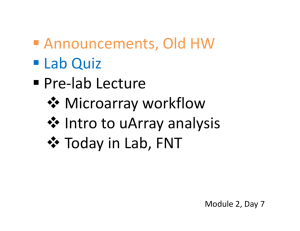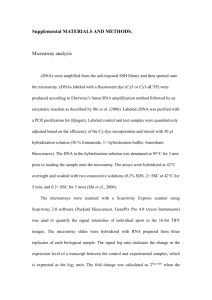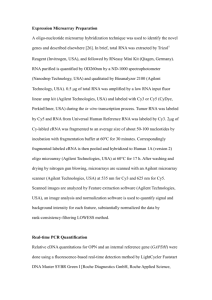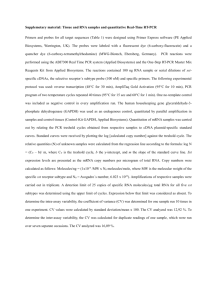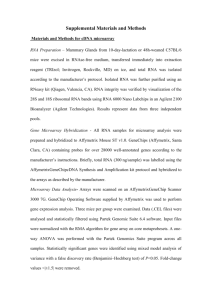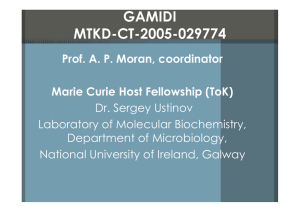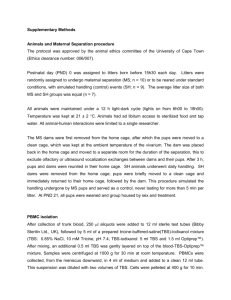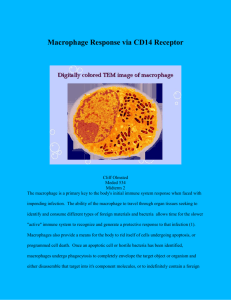Supplementary Methods - Word file (44 KB )
advertisement
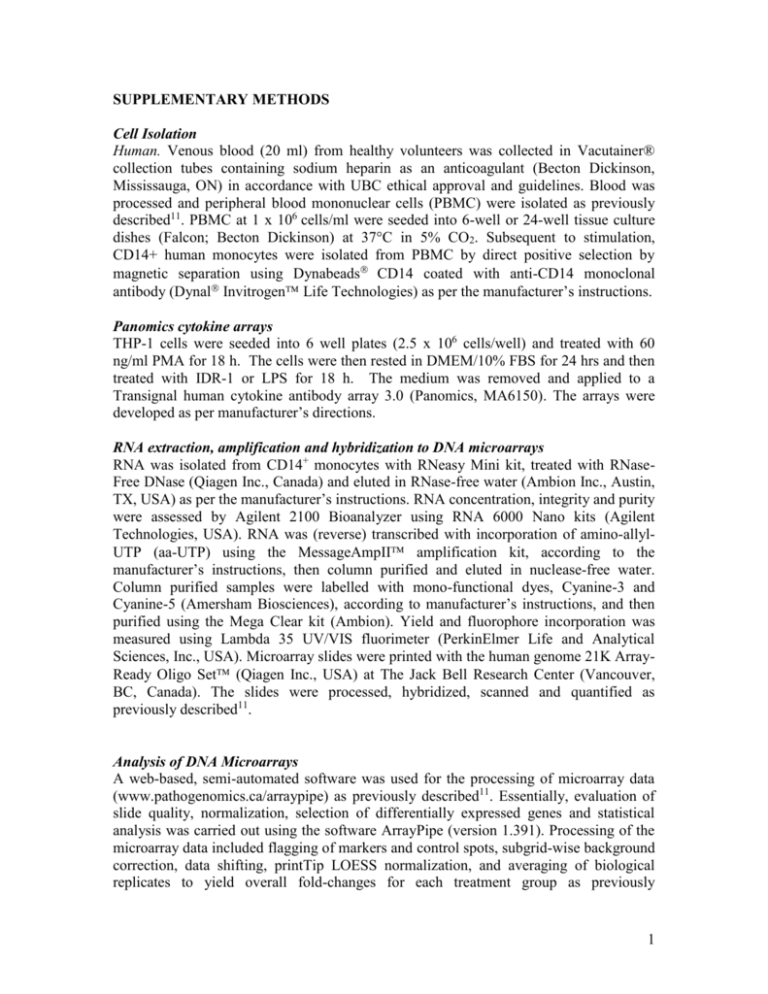
SUPPLEMENTARY METHODS Cell Isolation Human. Venous blood (20 ml) from healthy volunteers was collected in Vacutainer® collection tubes containing sodium heparin as an anticoagulant (Becton Dickinson, Mississauga, ON) in accordance with UBC ethical approval and guidelines. Blood was processed and peripheral blood mononuclear cells (PBMC) were isolated as previously described11. PBMC at 1 x 106 cells/ml were seeded into 6-well or 24-well tissue culture dishes (Falcon; Becton Dickinson) at 37°C in 5% CO2. Subsequent to stimulation, CD14+ human monocytes were isolated from PBMC by direct positive selection by magnetic separation using Dynabeads CD14 coated with anti-CD14 monoclonal antibody (Dynal Invitrogen Life Technologies) as per the manufacturer’s instructions. Panomics cytokine arrays THP-1 cells were seeded into 6 well plates (2.5 x 106 cells/well) and treated with 60 ng/ml PMA for 18 h. The cells were then rested in DMEM/10% FBS for 24 hrs and then treated with IDR-1 or LPS for 18 h. The medium was removed and applied to a Transignal human cytokine antibody array 3.0 (Panomics, MA6150). The arrays were developed as per manufacturer’s directions. RNA extraction, amplification and hybridization to DNA microarrays RNA was isolated from CD14+ monocytes with RNeasy Mini kit, treated with RNaseFree DNase (Qiagen Inc., Canada) and eluted in RNase-free water (Ambion Inc., Austin, TX, USA) as per the manufacturer’s instructions. RNA concentration, integrity and purity were assessed by Agilent 2100 Bioanalyzer using RNA 6000 Nano kits (Agilent Technologies, USA). RNA was (reverse) transcribed with incorporation of amino-allylUTP (aa-UTP) using the MessageAmpII amplification kit, according to the manufacturer’s instructions, then column purified and eluted in nuclease-free water. Column purified samples were labelled with mono-functional dyes, Cyanine-3 and Cyanine-5 (Amersham Biosciences), according to manufacturer’s instructions, and then purified using the Mega Clear kit (Ambion). Yield and fluorophore incorporation was measured using Lambda 35 UV/VIS fluorimeter (PerkinElmer Life and Analytical Sciences, Inc., USA). Microarray slides were printed with the human genome 21K ArrayReady Oligo Set (Qiagen Inc., USA) at The Jack Bell Research Center (Vancouver, BC, Canada). The slides were processed, hybridized, scanned and quantified as previously described11. Analysis of DNA Microarrays A web-based, semi-automated software was used for the processing of microarray data (www.pathogenomics.ca/arraypipe) as previously described11. Essentially, evaluation of slide quality, normalization, selection of differentially expressed genes and statistical analysis was carried out using the software ArrayPipe (version 1.391). Processing of the microarray data included flagging of markers and control spots, subgrid-wise background correction, data shifting, printTip LOESS normalization, and averaging of biological replicates to yield overall fold-changes for each treatment group as previously 1 described11. Two-sided one-sample Student’s t-test on the log2-ratios within each treatment group was used for statistical analysis of the data. Data has been submitted to Array Express under accession number E-FPMI-8. Quantitative real-time PCR (qPCR) Differential gene expression identified by microarray analysis was validated using quantitative real-time PCR (qPCR) using SuperScript™ III Platinum® Two-Step qRTPCR Kit with SYBR® Green (Invitrogen Life Technologies), as per the manufacturer’s instructions, in the ABI PRISM® 7000 sequence detection system (Applied Biosystems, Foster city, CA, USA). Briefly, 250 ng of total RNA was reverse transcribed in a 20 l reaction volume for 50 min at 42C, the reaction was terminated by incubating for 5 min at 85C and then digested for 30 min at 37C with RNAse H. The PCR reaction was carried out in a 12.5 l reaction volume containing 2.5 l of 1/10 diluted cDNA template. A melting curve was performed to ensure that any product detected was specific to the desired amplicon. Fold changes were calculated after normalization to endogenous GAPDH and using the comparative Ct method1. The primers used for qRT-PCR are reported in Supplementary Table 2. Supplementary Table 2: Sequence of primers (human) used for quantitative real-time PCR. Gene Forward primer (5’-3’) Reverse Primer (5’-3’) CXCL1 GCCAGTGCTTGCAGACCCT GGCTATGACTTCGGTTTGGG GAPDH GTCGCTGTTGAAGTCAGAGG GAAACTGTGGCGTGATGG IL-6 AATTCGGTACATCCTCGACGG GGTTGTTTTCTGCCAGTGCC IL-8 GACCACACTGCGCCAACAC CTTCTCCACAACCCTCTGCAC IL-10 GGTTGCCAAGCCTTGTCTGA AGGGAGTTCACATGCGCCT IL-19 GAGCCATCCAAGCTAAGGACA CTTGGTCACGCAGCACACAT MCP-1 TCATAGCAGCCACCTTCATTC TAGCGCAGATTCTTGGGTTG MCP-3 TGT CCT TTC TCA GAG TGG TTC T TGC TTC CAT AGG GAC ATC ATA MEK3 ATAGACCCAAGCGCATCACG GGATAAGGAAATCGGCCTGTG MEK6 GAAGGCAGATGACCTGGAGC TCACTGCCATGATCTGCCC 1 Pfaffl, M.W. 2001. A new mathematical model for relative quantification in real-time RT-PCR. Nucleic Acids Res. 29: No. 9 e45. 2



